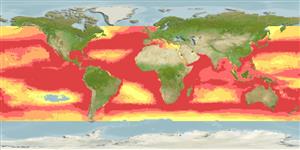Elasmobranchii (haaien en roggen) (sharks and rays) >
Carcharhiniformes (Ground sharks) >
Sphyrnidae (Hammerhead, bonnethead, or scoophead sharks)
Etymology: Sphyrna: Greek, sphyra = hammer (Ref. 45335).
Omgeving / Klimaat / Range
Ecologie
; marien; brakwater; oceanodroom (Ref. 13562); diepteverspreiding 0 - 200 m (Ref. 5578), usually 0 - 20 m (Ref. 55303). Subtropical, preferred 26°C (Ref. 107945); 59°N - 55°S, 180°W - 180°E
Widespread in temperate and tropical seas (Ref. 13562). Western Atlantic: Canada to the Virgin Islands; Brazil to Argentina. Eastern Atlantic: British Isles to Côte d'Ivoire, including the Mediterranean. Indo-Pacific: South Africa to Sri Lanka; southern Siberia to Viet Nam (Ref. 13562); southern Australia, New Zealand, and Hawaii (Ref. 13562). Eastern Pacific: northern California, USA to Chile.
Length at first maturity / Size / Gewicht / Leeftijd
Maturity: Lm ?, range 265 - ? cm
Max length : 500 cm TL mannelijk/geslacht niet bekend; (Ref. 35388); common length : 335 cm TL mannelijk/geslacht niet bekend; (Ref. 13562); Maximaal gepubliceerd gewicht: 400.0 kg (Ref. 9987)
Dorsale stekels (totaal): 0; Dorsale zachte stralen (totaal): 0; Anale stekels 0; Anale zachte stralen: 0. A large hammerhead with a notch at the center of head; 1st dorsal fin moderately high, 2nd dorsal and pelvic fins low (Ref. 5578). Olive-grey or dark grey above, white below (Ref. 5578). Fins nearly plain, dusky or blackish tipped (Ref. 13562).
Occurs inshore and well offshore (Ref. 5578), over continental and insular shelves (Ref. 244). Coastal, pelagic, and semi-oceanic, but often bottom associated at 1-139 m (Ref. 58302). Migrates northward in summer; young often in large aggregations of hundreds of individuals (Ref. 13562). Prefers to feed on small sharks, skates and stingrays, but also preys on bony fishes, shrimps, crabs, barnacles and cephalopods (Ref. 244). Viviparous (Ref. 50449). Regarded as being dangerous to people, though only few can be tentatively attributed to this species due to its occurrence in temperate waters (Ref. 244). Reported to cause poisoning (Ref. 4690). Caught occasionally by shark and tuna longline fisheries (Ref.58048). Meat utilized fresh, dried-salted, and possibly smoked for human consumption; liver oil for vitamins, fins for soup, hide for leather, and carcasses for fishmeal (Ref. 244). Used in Chinese medicine (Ref. 12166). Become sexually mature when 250 to 300 cm long. The female gives birth to 30 - 40 young (Ref. 35388).
Viviparous, placental (Ref. 50449), with 20 to 50 young per litter (Ref. 6871)after a gestation period of 10-11 months (Ref.58048). Size at birth between 50-60 cm TL (Ref. 13562).
Compagno, L.J.V., 1984. FAO Species Catalogue. Vol. 4. Sharks of the world. An annotated and illustrated catalogue of shark species known to date. Part 2 - Carcharhiniformes. FAO Fish. Synop. 125(4/2):251-655. Rome: FAO. (Ref. 244)
Status op de Rode Lijst van het IUCN (Ref. 115185)
Gebruik door de mens
Visserij: commercieel; vis voor de hengelsport: ja
Meer informatie
ReferentiesAquacultuurAquacultuurprofielKweeklijnenGeneticaAlleelfrequentiesErfelijkheidZiektenVerwerkingMass conversion
Tools
Speciale rapporten
Download XML
Internet-bronnen
